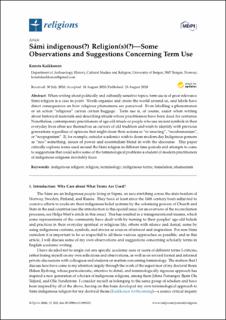| dc.contributor.author | Kaikkonen, Konsta Ilari | |
| dc.date.accessioned | 2021-07-01T08:58:03Z | |
| dc.date.available | 2021-07-01T08:58:03Z | |
| dc.date.created | 2020-09-28T14:59:58Z | |
| dc.date.issued | 2020 | |
| dc.Published | Religions. 2020, 11:409 (9), 1-14. | |
| dc.identifier.issn | 2077-1444 | |
| dc.identifier.uri | https://hdl.handle.net/11250/2762723 | |
| dc.description.abstract | When writing about politically and culturally sensitive topics, term use is of great relevance. Sámi religion is a case in point. Words organise and create the world around us, and labels have direct consequences on how religious phenomena are perceived. Even labelling a phenomenon or an action “religious” carries certain baggage. Term use is, of course, easier when writing about historical materials and describing rituals whose practitioners have been dead for centuries. Nonetheless, contemporary practitioners of age-old rituals or people who use ancient symbols in their everyday lives often see themselves as carriers of old tradition and wish to identify with previous generations regardless of opinions that might deem their actions as “re-enacting”, “neoshamanism”, or “neopaganism”. If, for example, outsider academics wish to deem modern-day Indigenous persons as “neo”-something, issues of power and essentialism blend in with the discourse. This paper critically explores terms used around the Sámi religion in different time periods and attempts to come to suggestions that could solve some of the terminological problems a student of modern practitioners of indigenous religions inevitably faces. | en_US |
| dc.language.iso | eng | en_US |
| dc.publisher | MDPI | en_US |
| dc.rights | Navngivelse 4.0 Internasjonal | * |
| dc.rights.uri | http://creativecommons.org/licenses/by/4.0/deed.no | * |
| dc.subject | Dekolonisering | en_US |
| dc.subject | Decolonization | en_US |
| dc.subject | Terminologi | en_US |
| dc.subject | Terminology | en_US |
| dc.subject | Sjamanisme | en_US |
| dc.subject | Shamanism | en_US |
| dc.subject | Samisk religion | en_US |
| dc.subject | Sami religion | en_US |
| dc.title | Sámi indigenous(?) religion(s)(?)—some observations and suggestions concerning term use | en_US |
| dc.type | Journal article | en_US |
| dc.type | Peer reviewed | en_US |
| dc.description.version | publishedVersion | en_US |
| dc.rights.holder | Copyright 2020 The Authors | en_US |
| dc.source.articlenumber | 432 | en_US |
| cristin.ispublished | true | |
| cristin.fulltext | original | |
| cristin.qualitycode | 1 | |
| dc.identifier.doi | 10.3390/rel11090432 | |
| dc.identifier.cristin | 1834362 | |
| dc.source.journal | Religions | en_US |
| dc.source.40 | 11:409 | |
| dc.source.14 | 9 | |
| dc.subject.nsi | VDP::Religionsvitenskap, religionshistorie: 153 | en_US |
| dc.subject.nsi | VDP::Religious studies, history of religion: 153 | en_US |
| dc.identifier.citation | Religions. 2020, 11(9), 432 | en_US |
| dc.source.volume | 11 | en_US |
| dc.source.issue | 9 | en_US |

